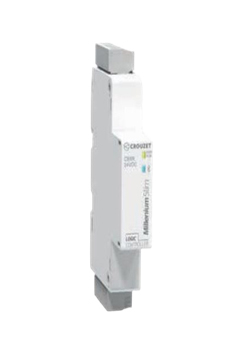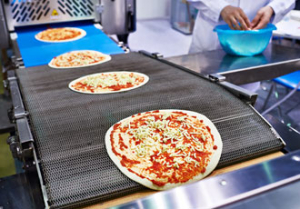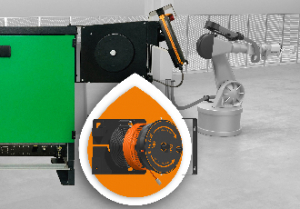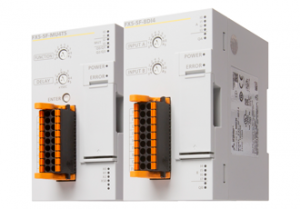Energy Saving In Hazardous Ex Environments Is About Using Smarter & More Integrated Valve, Actuator & Positioner Systems
23rd September 2010
Source:
Burkert Fluid Control Systems
The cost-down pressures inherent in all process industries mean that plant operators are consistently required to improve efficiency, at the same time as ensuring repeatable product quality. These requirements are not exclusive to general processing environments; they also include production sectors where hazardous environments - with their complex, demanding standards in terms of safety provision - predominate. In these environments companies are prepared to invest heavily in new plant and equipment in pursuit of efficiency savings. However, in many cases, real savings and efficiency improvements can be achieved relatively simply and at low cost by focussing on cutting down on energy usage.
With valves, pumps and fans used widely in food and beverage production, the possibilities for energy savings are considerable. Take compressed air, for example; its generation is equivalent to about 10% of industry’s total electricity usage, rising to 30% in some sectors. This highlights why companies have compelling reasons to pursue energy saving initiatives in this area. However, one area of pneumatic energy saving potential is still largely unexploited: improved process valve control techniques. These can lead to reduced compressed air use through the adoption of on-actuator or in-actuator pneumatic solenoid valves.
At present, the majority of pneumatically piloted valves on production and process lines centralise pneumatic control around valve islands in a control cabinet or enclosure. This arrangement means that the pipework carrying the pilot pressure to the actual valve from the valve island can travel for many metres before it reaches the valve head. As a result, the venting cycle of the valves operation will exhaust proportionately more air than is necessary.
The solution to this problem is Burkert’s Type 8690 EEx valve control heads. Developed for use in the food, beverage and pharmaceutical industries, these units provide a decentralised method of opening and closing of process valves automatically, eliminating the need for the wasteful venting of control air normally associated with pneumatic tubing between the process valve and its related control solenoid valve.
The control heads integrate electrical and pneumatic control components as well as position feedback units and, optionally, field bus interfaces for AS-Interface or DeviceNet. They are mounted directly above the valve body, and, because there is little or no distance between the actuator and the valve that it is piloting, there is no air bleed: it is sealed.
With this system the pressure feed goes directly into the valve head and the control signal is supplied either from a local closed loop control sensor or switch; or from a PLC / machine controller via a control bus - AS-Interface or DeviceNet – or multipole (parallel) directly into the valve.
Similarly, adopting digital positioners with integral solenoid valve control heads for regulating modulating process control valves will automatically lead to air savings, as these will normally ensure zero-air use in their stable state. The traditional technique of process valve positioners incorporating pneumatic flapper-nozzle systems means that air is being bled constantly, even when the valve is at rest. This can average the equivalent of a 0.75kW (or one-horsepower) in compressed air for every twenty valves in operation; a large process site can therefore be using a vast amount of energy – unnecessarily.
Choosing the option of an embedded PID process controller, working in conjunction with the positioner, provides a fast-acting, decentralised control loop in combination with the associated process sensor. This arrangement also reduces complexity and saves unnecessary components and wiring.
An extension of this integration concept, which also delivers considerable savings in energy, is intelligent valve systems. In the field of process valves, conventional automation solutions, including control cabinets with valve terminals, I/O systems and field bus connections, require extensive and costly tube connections and wiring.
With this technology, the valves at field level are connected to the control unit in the control cabinet through a large number of extended pneumatic control lines and discrete feedback connections. In many cases, long control air lines increase the air consumption and have a negative effect on the switching times of the valves. In addition, apart from the high costs for planning and installation of such solutions, there are also concerns as regards hygiene.
This is because every additional control air and feedback line within the production plant is a potential source of contamination and risk, and must therefore be monitored, serviced and cleaned regularly, which is a costly undertaking.
The use of innovative intelligent process valves eliminates these problems, as automation functions - pilot valves, electrical and optical position feedback and field bus interfaces - are integrated directly into the actuators of process valves. This approach, based upon the principle of decentralised automation, minimises the number of cables and compressed air lines, reducing air consumption considerably.
Where intelligent valve systems are not an option, another alternative is ATEX Ex- rated valve islands. In zone 1/21 hazardous areas, the pneumatic control of cylinders and pneumatic actuators is generally achieved with either discrete explosion-proof valves, directly mounted to the actuator, or Ex-proof valve banks wired to a remote-I/O-system. Installing the pilot valves in a safe area is a further option – although often not possible as the large distances between valves and actuators lead to unacceptably long switching times.
However, connecting sensors and actuators to bus systems substantially reduces the wiring effort. The use of advanced Profibus DPV1 communications relieves the control engineer of the task of installing the many special expensive electrical junctions and terminations required by conventional field wired systems in ATEX areas. It also offers additional major benefits, including a more compact control system, a more ‘close-to-the-process’ installation, minimal power consumption, and, hence, significant cost savings.
In addition, new ex-proof electro-pneumatic automation systems, such as Burkert’s Type 8650 offer another important advantage: all elements, valves (etc) are harmonised and certified. This means that users do not have to provide evidence of the safety of the system. Instead, Burkert provides a certificate covering the complete control cabinet, enabling users to guarantee that all devices and elements are consistent to EN 60079 part 0/1/7/11/26 and EN 60529:
As Burkert’s AirLINE Ex 8650 unit is fully certified, it can be used in explosion-hazard areas with gas or dust atmospheres. The system is particularly suited to decentralised process control tasks concerning fine chemicals, pharmaceuticals and cosmetics; and it can be employed anywhere where solvents, alcohol or lacquers are utilised. It can even be installed for direct factory automation: e.g. for the automatic filling of solvents, alcohol or lacquers. In these application areas, the new system is unique; in so far as it is the only compact electro-pneumatic automation solution allowing integration of EExia pneumatic valves without additional wiring.
Standardised interfaces and a highly flexible and modular design guarantee a fast and easy system-setup and allow pneumatic, electric and electronic modules with diverse functions to be combined with each other. The system allows up to 48 Burkert EExia solenoid valves to be seamlessly combined with Siemens ET200iSP EExia/ib electronic digital and analogue I/O modules in single distributed I/O assemblies. These offer extensive facilities for remote parameter setting and diagnostics, the ability to “Hot -Swap” valves and electronic I/O modules under Ex-
At present, the majority of pneumatically piloted valves on production and process lines centralise pneumatic control around valve islands in a control cabinet or enclosure. This arrangement means that the pipework carrying the pilot pressure to the actual valve from the valve island can travel for many metres before it reaches the valve head. As a result, the venting cycle of the valves operation will exhaust proportionately more air than is necessary.
The solution to this problem is Burkert’s Type 8690 EEx valve control heads. Developed for use in the food, beverage and pharmaceutical industries, these units provide a decentralised method of opening and closing of process valves automatically, eliminating the need for the wasteful venting of control air normally associated with pneumatic tubing between the process valve and its related control solenoid valve.
The control heads integrate electrical and pneumatic control components as well as position feedback units and, optionally, field bus interfaces for AS-Interface or DeviceNet. They are mounted directly above the valve body, and, because there is little or no distance between the actuator and the valve that it is piloting, there is no air bleed: it is sealed.
With this system the pressure feed goes directly into the valve head and the control signal is supplied either from a local closed loop control sensor or switch; or from a PLC / machine controller via a control bus - AS-Interface or DeviceNet – or multipole (parallel) directly into the valve.
Similarly, adopting digital positioners with integral solenoid valve control heads for regulating modulating process control valves will automatically lead to air savings, as these will normally ensure zero-air use in their stable state. The traditional technique of process valve positioners incorporating pneumatic flapper-nozzle systems means that air is being bled constantly, even when the valve is at rest. This can average the equivalent of a 0.75kW (or one-horsepower) in compressed air for every twenty valves in operation; a large process site can therefore be using a vast amount of energy – unnecessarily.
Choosing the option of an embedded PID process controller, working in conjunction with the positioner, provides a fast-acting, decentralised control loop in combination with the associated process sensor. This arrangement also reduces complexity and saves unnecessary components and wiring.
An extension of this integration concept, which also delivers considerable savings in energy, is intelligent valve systems. In the field of process valves, conventional automation solutions, including control cabinets with valve terminals, I/O systems and field bus connections, require extensive and costly tube connections and wiring.
With this technology, the valves at field level are connected to the control unit in the control cabinet through a large number of extended pneumatic control lines and discrete feedback connections. In many cases, long control air lines increase the air consumption and have a negative effect on the switching times of the valves. In addition, apart from the high costs for planning and installation of such solutions, there are also concerns as regards hygiene.
This is because every additional control air and feedback line within the production plant is a potential source of contamination and risk, and must therefore be monitored, serviced and cleaned regularly, which is a costly undertaking.
The use of innovative intelligent process valves eliminates these problems, as automation functions - pilot valves, electrical and optical position feedback and field bus interfaces - are integrated directly into the actuators of process valves. This approach, based upon the principle of decentralised automation, minimises the number of cables and compressed air lines, reducing air consumption considerably.
Where intelligent valve systems are not an option, another alternative is ATEX Ex- rated valve islands. In zone 1/21 hazardous areas, the pneumatic control of cylinders and pneumatic actuators is generally achieved with either discrete explosion-proof valves, directly mounted to the actuator, or Ex-proof valve banks wired to a remote-I/O-system. Installing the pilot valves in a safe area is a further option – although often not possible as the large distances between valves and actuators lead to unacceptably long switching times.
However, connecting sensors and actuators to bus systems substantially reduces the wiring effort. The use of advanced Profibus DPV1 communications relieves the control engineer of the task of installing the many special expensive electrical junctions and terminations required by conventional field wired systems in ATEX areas. It also offers additional major benefits, including a more compact control system, a more ‘close-to-the-process’ installation, minimal power consumption, and, hence, significant cost savings.
In addition, new ex-proof electro-pneumatic automation systems, such as Burkert’s Type 8650 offer another important advantage: all elements, valves (etc) are harmonised and certified. This means that users do not have to provide evidence of the safety of the system. Instead, Burkert provides a certificate covering the complete control cabinet, enabling users to guarantee that all devices and elements are consistent to EN 60079 part 0/1/7/11/26 and EN 60529:
As Burkert’s AirLINE Ex 8650 unit is fully certified, it can be used in explosion-hazard areas with gas or dust atmospheres. The system is particularly suited to decentralised process control tasks concerning fine chemicals, pharmaceuticals and cosmetics; and it can be employed anywhere where solvents, alcohol or lacquers are utilised. It can even be installed for direct factory automation: e.g. for the automatic filling of solvents, alcohol or lacquers. In these application areas, the new system is unique; in so far as it is the only compact electro-pneumatic automation solution allowing integration of EExia pneumatic valves without additional wiring.
Standardised interfaces and a highly flexible and modular design guarantee a fast and easy system-setup and allow pneumatic, electric and electronic modules with diverse functions to be combined with each other. The system allows up to 48 Burkert EExia solenoid valves to be seamlessly combined with Siemens ET200iSP EExia/ib electronic digital and analogue I/O modules in single distributed I/O assemblies. These offer extensive facilities for remote parameter setting and diagnostics, the ability to “Hot -Swap” valves and electronic I/O modules under Ex-
Similar articles
More from Burkert Fluid Control Systems
- Continuous water quality analysis for boreholes 6th July 2020
- Controller delivers precision microlitre dosing 14th May 2020
- Multi-medium testing facility for fluidic components 19th March 2020
- Micro precision for time-pressure dosing 10th December 2019












Write a comment
No comments